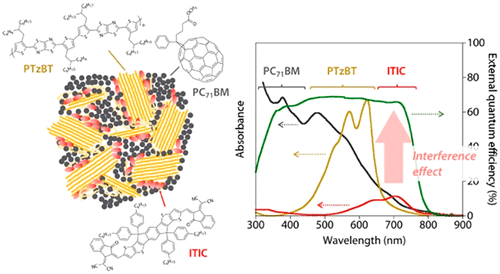当前位置:
X-MOL 学术
›
Macromolecules
›
论文详情
Our official English website, www.x-mol.net, welcomes your
feedback! (Note: you will need to create a separate account there.)
Significantly Sensitized Ternary Blend Polymer Solar Cells with a Very Small Content of the Narrow-Band Gap Third Component That Utilizes Optical Interference
Macromolecules ( IF 5.1 ) Pub Date : 2020-11-25 , DOI: 10.1021/acs.macromol.0c01787 Masahiko Saito 1 , Yasunari Tamai 2 , Hiroyuki Ichikawa 3 , Hiroyuki Yoshida 3, 4 , Daisuke Yokoyama 5 , Hideo Ohkita 2 , Itaru Osaka 1
Macromolecules ( IF 5.1 ) Pub Date : 2020-11-25 , DOI: 10.1021/acs.macromol.0c01787 Masahiko Saito 1 , Yasunari Tamai 2 , Hiroyuki Ichikawa 3 , Hiroyuki Yoshida 3, 4 , Daisuke Yokoyama 5 , Hideo Ohkita 2 , Itaru Osaka 1
Affiliation

|
Increasing photon harvest is an essential issue in improving the efficiency of organic photovoltaics. Here, we study ternary blend polymer solar cells that are composed of a thiazolothiazole-based crystalline semiconducting polymer and a fullerene derivative as the host binary system and a very small content of a series of narrow-band gap non-fullerene acceptors as the third-component sensitizer that is selectively located at the interface between the host donor and acceptor. Surprisingly, the cells give an external quantum efficiency in the sensitizer absorption range that is as high as that in the polymer absorption range despite the fact that the optimal sensitizer content is only 6 wt %, which is far smaller than the host polymer contents. This leads to significantly improved photocurrents and, in turn, high power conversion efficiencies relative to the binary blend cell. Such pronounced sensitization is found to originate in the markedly amplified sensitizer absorption owing to the optical interference effect of more than 300 nm-thick photoactive layers. In parallel, the ternary blend system realizes markedly reduced photon energy loss, which is also important for the power conversion efficiency improvement, and high thermal stability. With such excellent features, we believe that the sensitized ternary blend cells have exceptional possibilities and that exploring more well-matched material combinations would improve the performance further.
中文翻译:

具有非常小含量的利用光干涉的窄带隙第三成分的三元共混聚合物太阳能电池
增加光子收成是提高有机光伏效率的重要问题。在这里,我们研究三元共混聚合物太阳能电池,该电池由基于噻唑并噻唑的晶体半导体聚合物和富勒烯衍生物作为主体二元体系,以及非常少量的一系列窄带隙非富勒烯受体作为第三种共混聚合物。组分敏化剂,选择性地位于宿主供体和受体之间的界面。出乎意料的是,尽管最佳敏化剂含量仅为6wt%,远小于主体聚合物的含量,但是在给定的光敏剂吸收范围内,电池给出的外部量子效率与在聚合物吸收范围内的外部量子效率一样高。这样可以显着改善光电流,进而 相对于二元混合电池,功率转换效率高。由于超过300 nm厚的光敏层的光干涉效应,发现这种明显的敏化作用是由于显着放大的敏化剂吸收引起的。同时,三元混合系统可显着降低光子能量损失,这对于提高功率转换效率和高热稳定性也很重要。凭借如此出色的功能,我们相信敏化的三元共混电池具有特殊的可能性,并且探索更匹配的材料组合将进一步改善性能。由于超过300 nm厚的光敏层的光干涉效应,发现这种明显的敏化作用是由于显着放大的敏化剂吸收引起的。同时,三元混合系统可显着降低光子能量损失,这对于提高功率转换效率和高热稳定性也很重要。凭借如此出色的功能,我们相信敏化的三元共混电池具有特殊的可能性,并且探索更匹配的材料组合将进一步改善性能。由于超过300 nm厚的光敏层的光干涉效应,发现这种明显的敏化作用是由于显着放大的敏化剂吸收引起的。同时,三元混合系统可显着降低光子能量损失,这对于提高功率转换效率和高热稳定性也很重要。凭借如此出色的功能,我们相信敏化的三元共混电池具有特殊的可能性,并且探索更匹配的材料组合将进一步改善性能。
更新日期:2020-12-08
中文翻译:

具有非常小含量的利用光干涉的窄带隙第三成分的三元共混聚合物太阳能电池
增加光子收成是提高有机光伏效率的重要问题。在这里,我们研究三元共混聚合物太阳能电池,该电池由基于噻唑并噻唑的晶体半导体聚合物和富勒烯衍生物作为主体二元体系,以及非常少量的一系列窄带隙非富勒烯受体作为第三种共混聚合物。组分敏化剂,选择性地位于宿主供体和受体之间的界面。出乎意料的是,尽管最佳敏化剂含量仅为6wt%,远小于主体聚合物的含量,但是在给定的光敏剂吸收范围内,电池给出的外部量子效率与在聚合物吸收范围内的外部量子效率一样高。这样可以显着改善光电流,进而 相对于二元混合电池,功率转换效率高。由于超过300 nm厚的光敏层的光干涉效应,发现这种明显的敏化作用是由于显着放大的敏化剂吸收引起的。同时,三元混合系统可显着降低光子能量损失,这对于提高功率转换效率和高热稳定性也很重要。凭借如此出色的功能,我们相信敏化的三元共混电池具有特殊的可能性,并且探索更匹配的材料组合将进一步改善性能。由于超过300 nm厚的光敏层的光干涉效应,发现这种明显的敏化作用是由于显着放大的敏化剂吸收引起的。同时,三元混合系统可显着降低光子能量损失,这对于提高功率转换效率和高热稳定性也很重要。凭借如此出色的功能,我们相信敏化的三元共混电池具有特殊的可能性,并且探索更匹配的材料组合将进一步改善性能。由于超过300 nm厚的光敏层的光干涉效应,发现这种明显的敏化作用是由于显着放大的敏化剂吸收引起的。同时,三元混合系统可显着降低光子能量损失,这对于提高功率转换效率和高热稳定性也很重要。凭借如此出色的功能,我们相信敏化的三元共混电池具有特殊的可能性,并且探索更匹配的材料组合将进一步改善性能。











































 京公网安备 11010802027423号
京公网安备 11010802027423号